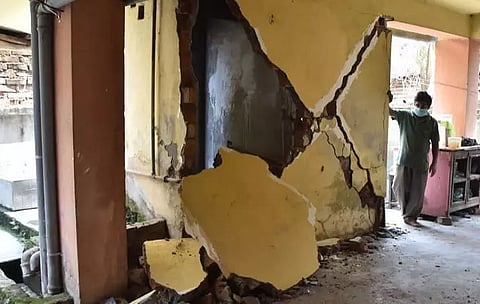
- Home
- Live Blog
- Breaking News
- Top Headlines
- Cities
- NE News
- Sentinel Media
- Sports
- Education
- Jobs

Wednesday morning's earthquake measuring 6.4 on Richter scale with epicentre at Dhekiajuli in Sonitpur district put Assam to the toughest test of preparedness and management of twin or multiple disasters striking simultaneously. Ten aftershocks that followed in the midst of a grim COVID-19 pandemic situation have sounded the alarm bell for the Assam State Disaster Management Authority (ASDMA) to take stock of alertness for major earthquakes occurring during deteriorating pandemic situation like the current wave of COVID-19. Cracks in multi-storey private and public buildings, disruption of train services due to cracks on railway bridge, liquefaction of open grounds on account of Wednesday's earthquake call for updating the disaster management plan for re-strategizing rescue and rehabilitation during simultaneous occurrences of multiple disasters like pandemic, earthquake, and floods. Gushing of water through the cracks in open grounds revived haunting childhood memories of the great earthquake of 1950 in Assam for many. Two major earthquakes in 1897 and 1950, each measuring 8.7 magnitude on the Richter Scale left trails of unprecedented devastation across undivided Assam. In recent years, the Sikkim earthquake of 6.9 magnitude left a trail of devastation in the hill state in 2011. The COVID-19 pandemic has already overwhelmed the health system in the state and in the event of a devastating earthquake resulting in injury of scores of people it will be a health catastrophe if adequate hospital beds with critical care supports and ambulances are not readily available. The National Centre for Seismology (NCS) in its report stated that the epicentre of Wednesday's earthquake was located near to Kopili Fault closer to Himalayan Frontal Thrust. "The area is seismically very active falling in the highest Seismic Hazard zone V associated with collisional tectonics where Indian plate subducts beneath the Eurasian Plate," the report adds. According to NCS, the ten aftershocks of magnitude ranging from 3.2 to 4.7 from the time of occurrence of the main shock at a focal depth of 17 km signify the release of the stress in the vicinity of the source zone in and around Sonitpur. Wednesday's earthquake has triggered fresh apprehension over the safety and cascading downstream impact of mega dams under construction and proposed to be built in Arunachal Pradesh, Bhutan and Tibet regions of China for hydropower generation. The ASDMA issued emergency toll-free numbers 1070/1079 and 1077 to facilitate public report earthquake damage. The cracks in several multi-storey buildings in Guwahati, dangerous leaning of a building on the adjacent building in Nagaon exposed the failure of the authorities to monitor and ensure strict adherence to local safe building codes by builders and owners. A comprehensive review of the safety status of all multi-storey buildings including educational institutions, government and private offices, public auditoria, marriage hall should be undertaken check for adherence to prescribed building codes. Any leniency towards erring builders, engineers or owners will seriously jeopardise public safety in earthquake or incidents of fire emergency. Earthquakes can neither be predicted nor prevented. However, alertness and preventive measures besides meticulous rescue plans can minimise fatalities and collateral damage even in earthquakes of higher magnitude. Unlike flood and cyclone which are seasonal, earthquake, fire and epidemics can occur anytime and hence the authorities from the state, district, sub-division, down to locality or village level must remain alert with comprehensive pre-disaster and post-disaster management plan. The state has well-laid out Emergency Support Function mechanism activation of which in the event of outbreak of a disaster has been made easier with the application of digital technology. Adherence by people to all prescribed safety protocols in all disaster situation is a must to minimise damage. The content of display boards on do's and don'ts during and after an earthquake at prominent places in city and town localities as well as in villages, marketplaces, educational institutions are needed to be enhanced with innovative ideas to attract attention of people. Audio and video messaging through social media networks on safety measures to be taken in a disaster situation must be carried out frequently to keep reminding of the need for alertness in a state like Assam and other states in Northeast region which are located in a high seismic zone. The Sonitpur earthquake is a wake-up call to ASDMA authorities that even in pandemic situation the awareness drive on earthquake preparedness and alertness must continue and cannot be put in the backburner. The state also needs to remain prepared to maintain the lifeline support and deal with simultaneous occurrence of earthquake, a peak in COVID-19 pandemic and high flood situation. This calls for a paradigm shift of focusing on occurrence of a single disaster situation to multiple disaster situation. The solution lies in augmenting emergency plans. Alertness and awareness can reduce panic among people during an earthquake which is vital to minimise collateral damage.